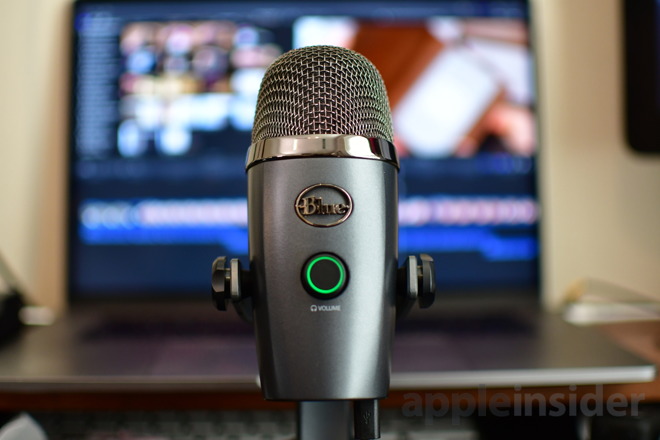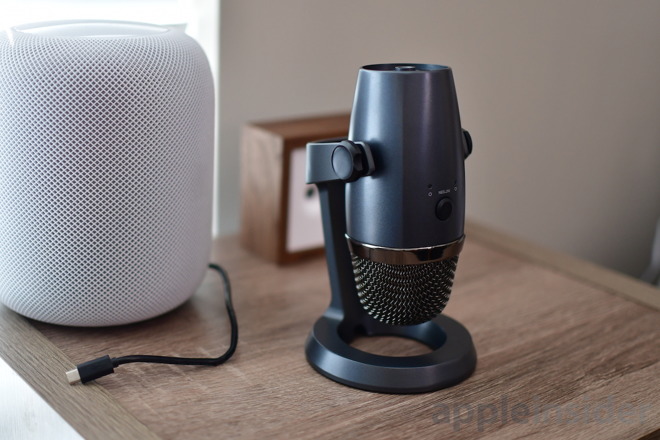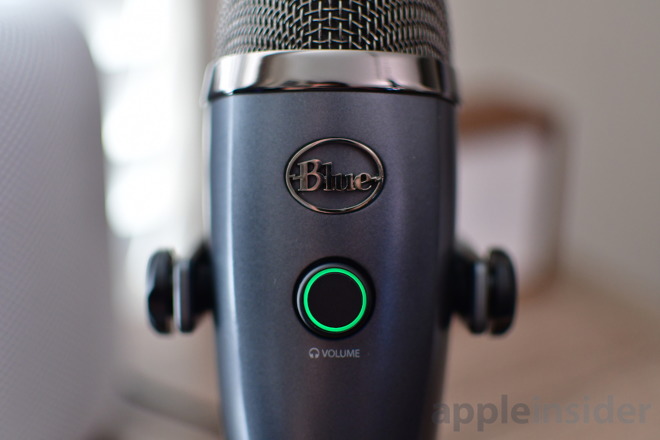Blue's latest microphone -- the Yeti Nano -- is a miniaturized version of the company's popular Yeti USB mic. AppleInsider has spent the last couple weeks testing it out ahead of the launch and we are very pleased with this stout recorder.

What is it
Blue has a reputation in the world of podcasts, streamers, and gamers. The company's products are solidly built, with exceptional sound quality that still comes in at entirely accessible price points.
Yeti Nano is a shrunken down version of the company's flagship Yeti, that keeps the build and sound quality, but trades in the bulky body.
It still interfaces with your PC or Mac with USB, and only lacks a few features found in its larger brethren.

There is a definite size difference between the two mics, though the Nano still wouldn't be considered small.
Fit and finish
Metal largely makes up the body of the Yeti Nano. It feels hefty and solid in-hand. Rotating the top of the mic down makes it even more compact if it ever needs to be tucked away.
Along the bottom, a notch is located towards the back of the round base as a cable routing channel.

Controls on the Yeti Nano are minimal, with a sole multi purpose button on the front and another on the back.
When the Yeti Nano is plugged in, the button on the front lights up green. When pressed, the mic is muted and the button turns red. Rotating the knob adjusts volume, independent from the computers volume.
On the rear, this second button allows you to switch between the two different capture modes -- cardioid and omnidirectional. A light gives you helpful feedback of which one is currently selected. Additionally, pressing the button for two seconds will turn on or off voice monitoring mode.
Directly under the mic there is a 3.5mm headphone jack for lag-free audio monitoring and a micro USB port for connectivity. We've said it many times, but we wish that Blue would've gone with USB-C rather than the legacy micro.
Sitting between that headphone jack and USB port is a quarter-inch threaded mount. A metal quarter-inch to five-eighths threaded adapter is also included which is handy and often overlooked by mic-makers. Inclusion of the adapter should allow it to work with almost any mic mount right out of the box.
Speaking of mounts, the Yeti Nano is very easy to remove from the desktop mount, and reinstallation is just as easy. The original Yeti can be quite a headache in this regard, so it is nice to see the Yeti Nano improve on this.
Audio quality
After using Yeti Nano quite a bit, we can very certainly say that it sounds nearly as good as the original Yeti. The full-size Yeti may be a small amount cleaner than the Yeti Nano, but we were surprised at how similar they actually were to one another.
Sound is crisp and easily picked up, even from a distance away. Gain cannot be controlled directly on the mic, so that is a downside, but the included software does enable you to control it from there.
Yeti Nano is able to record in either 16- or 24-bit which offers a bit of flexibility in the quality. Frequency response is 20Hz to 20kHz and has a max sound pressure level (SPL) of 110 decibels.
Yeti Nano vs Yeti
There are quite a few differences between the two, some more important than others. Looking at raw specs, most are the same though the max SPL is a bit higher (120db vs 110db) on the original Yeti.
The original also is limited to 16-bit, while the newer Yeti Nano is capable of 24-bit.
Venturing to controls, the Yeti has two more polar modes on top of the shared cardioid and omnidirectional -- stereo and bi-directional. Bi-directional is the most useful of the two, perfect for doing interviews. If those are a commonality in your recordings, then the original Yeti is probably a better choice than the Yeti Nano.
More controls are also present on the Yeti, including a dedicated mute button and gain adjustment.
Of course, Yeti also has the superior audio quality over the Yeti Nano, but not by much.
Get recording!
Yeti nano is a fantastic re-imagining of the popular Yeti. It retains all the great features of the Yeti in a smaller -- and more affordable -- package.
When traveling, we still would opt for something like the Blue Raspberry rather than toting the Yeti Nano along.
There are a few niche areas where the original Yeti excels such as when interviews are on the table, but for the vast majority, Yeti Nano will be the preferable option.
Rating: 4.5 out of 5
Where to buy
Yeti Nano is available to order now from Amazon for $99, which is $29 cheaper than the original Yeti. It also comes in four different finishes -- Shadow Grey, Vivid Blue, Red Onyx, and Cubano Gold -- but Cubano Gold is not available at launch. If you are looking for truly better quality, the Yeti Pro is the way to go which will run you $249.